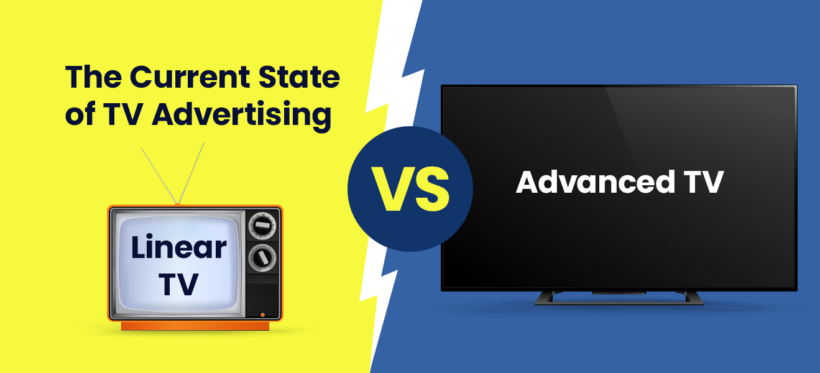In the good old days, TV represented one thing – a device that provided you with a certain TV-program at a specific time of the day. That is why during the World Cup final or a “spicy” TV episode you had to leave work earlier, skip an important meeting, or tell your grandma that you can’t come for dinner so that you could rush home and watch your favorite show.
Those days of traditional TV are far from being over, but there have been some drastic changes over the last years, in content, in viewers’ approach and advertising on TV.
Types of television: Advanced TV and Linear TV
Today we have so many choices that it is hard not to get overwhelmed. To simplify things there are two main TV categories: linear TV and advanced TV. To make some sense out of it, we would need to break down what is what.
Linear TV is a real-time TV service that broadcasts through satellite or cable shows/programs at a scheduled time. Its target audience is getting older, and these are usually people who are comfortable with a more familiar experience.
On the contrary, Advanced TV is a way to watch preferred content with the use of non-linear (cable) TV delivery models, usually through the internet or digital complements. This is a kind of TV where you dictate your preferences rather than having to adjust. Another question is which age group prefers this type of television. The answer is predominantly young and active people (e.g., college students) who are very impatient (unwilling to wait).
There is a myriad of terms related to advanced TV service, and we can single out those in focus of advertising industry:
OTT/Connected TV – where CTV refers to means of watching television by connecting to the internet via specific device, and OTT refers to such content. In short, they both mean that this kind of connection provides viewers with a greater choice of content than it is available through cable (linear) television.
Connected TV is generally regarded as something that allows the content to go on the Big Screen, OTT content may be watched on any device, such as a smartphone or a desktop for example.
Addressable TV usually refers straight to the ad experience. When we consider this model, ads can be tailored specifically to the interests of a certain user/household. AI algorithms collect data. It means that various ads can be shown to different people watching the same program. Addressable television implies broadcasting ads at the level of a household, through cable, satellite, and set-top box systems.
Now there is also an Addressable VOD (Video On Demand) that provides targeted advertising to subscribers of this system of individual TV programs delivery, that is a kind of the next level of linear television (VOD allows viewers not only to access preferable content whenever they want but also to pause or forward/rewind).
The benefits of Advanced TV advertising
For a very long time, linear TV has been an undeniable leader when it came to marketing/advertising budgets. But today, when all media is getting digitized, TV budgets are shifting to advanced TV as well. The western world witnesses more and more of so-called cord-cutters, people who have decided to abandon paid cable or satellite television. According to the eMarketer forecasts, by 2023, the number of pay-TV users will drop to 72,7 million from 86,5 million in 2019. The main reason: connected TV provides a greater variety at a better price.
Here are some obvious advantages of advertising on advanced TV:
- possibility to watch content out of home (as Uscreen states, the OTT market was worth $121.61 billion in 2019 and will grow to $1.039 trillion by 2027);
- targeting specific people/households, and thus resulting in higher relevance and ROI;
- constant audience growth;
- variety of ad formats: from interstitial and native to video banners;
- interaction with users (sending them to the company’s site/asking questions);
- easy tracking and real-time analytics;
- transparency and brand safety;
- cross-device connectivity.
The current state of the Advanced TV ad environment
The one-size-fits-all model is a thing of the past. Advertising these days is so adjustable, it is almost liquid. Depending on one’s goals today, it is both easier and seemingly harder to advertise on TV than before. Easier because there are so many instruments, and seemingly harder because there are so many content providers, brands, and competitors.
Speaking of CTV devices that provide access to world’s top streaming services and live channels, according to CNET, in Q3 of 2019 the share of time spent watching OTT content was split between the following market players: Amazon Fire TV – 20%, Apple TV and XBOX – both 9%.
Ad tech never sleeps, and to make the harder bit easier, there are platforms that turn TV channels into personalized ad spaces. Take for example, a marketing platform that will place your ads in front of millions of the most popular CTV platform in the USA viewers based on demographics, interests, location, device, and so helping to beat the competition and requiring payment for an acquired audience only.
The key takeaways
Despite linear TV still being a great source for advertising, as the world is getting digitized, advertising on Advanced TV is gaining momentum. Its ability to target an audience based on various categories of interests and socio-demographic characteristics gives it obvious advantages: both in terms of getting the message across and saving money while targeting only the correct audience. Add real-time analytics and an opportunity to connect with your viewers across various devices – and you might just get the perfect recipe for a 2020 and on advertising tool.

